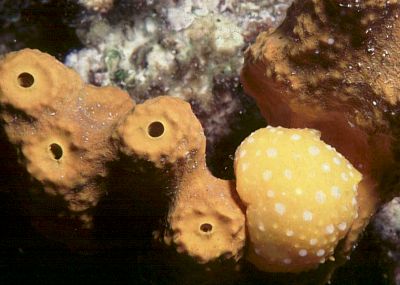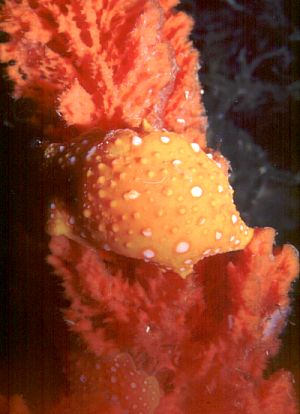Food of Phyllidia flava?
November 3, 2001
From: Baki Yokes


Dear Bill,
Here are photos of two different specimens of Phyllidia flava (if I'm not wrong). As far as I know, these slugs are found on sponges of Axinella sp. or Acanthella sp. These animals are mostly found in Middle and North Agean waters around Turkish coasts. The northern part is rich in Axinella and Acanthella species, but they are rarely seen in the shallow waters of Middle Agean. In these regions P. flava prefer another type of sponge. They are always orange in colour if they are found on Axinella or Acanthella, but always yellow in colour, if found on this yellow sponge. I would like to know if these animals use the pigments of the sponge they eat, and is it possible for them to change their colour if the food is changed? I will also be pleased if someone identify this yellow sponge.
UPPER RIGHT: Ayvalýk, Turkey. Divesite: Yuvarlak Ada. Depth: 10m. Size: approx. 4cm. May 1996
LOWER RIGHT: Canakkale, Turkey. Divesite: Saros Bay. Depth: 15m., Size: approx. 4cm. April 1995
Best regards
Baki
bakiyokes@turk.net
Yokes, B., 2001 (Nov 3) Food of Phyllidia flava?. [Message in] Sea Slug Forum. Australian Museum, Sydney. Available from http://www.seaslugforum.net/find/5581Dear Baki,
Some dorids, such as species of Rostanga do obtain pigments from their sponge food but i don't know if any studies have been done on Phyllidia flava. Concerning the sponge they are on - I am not a sponge expert and even less a Mediterranean sponge expert - so I make my thoughts in the form of a question. Would I be right in identifying the orange sponge in the lower photo as a species of Acanthella ? Secondly, the sponge in your upper photo looks like a species of Axinella. I think there are a number of species of Axinella, with different growth forms, so it could be possible that your mystery sponge is a species of Axinella.
Hopefully someone who knows what they are talking about will be able to enlighten us. Unfortunately sponges have many growth forms. Getting them identified is more difficult than getting gorgonians identified - and getting two sponge experts to agree is the next hurdle.
Best wishes,
Bill Rudman
Related messages
-
Gills of Phyllidia flava
From: Marcel Tanke, October 16, 2009 -
Re: Phyllidia flava in defensive mode
From: Dominique Horst, May 8, 2009 -
Phyllidia flava feeding
From: Dominique Horst, April 11, 2007 -
Re: Armina maculata or Phyllidia flava
From: Dominique Horst, June 1, 2006 -
Armina maculata or Phyllidia flava
From: Dominique Horst, May 31, 2006 -
Phyllidia flava from Greece
From: Vasilis Athanasopoulos, November 22, 2005 -
Phyllidia flava from Turkey
From: Ferda Buyukbaykal, January 24, 2003 -
Re: Phyllidia flava diet inTurkey
From: Jean Vacelet, December 7, 2001 -
Phyllidia flava feeding
From: Erwin Koehler, June 20, 2000 -
Unknown nudibranch from south of France
From: Christian Desprez, June 16, 2000
